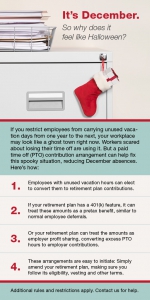How employers can help their employees with Social Security planning
/in Uncategorized/by Raffensperger Martin Finkenbiner RMFYour employees’ retirement timing decisions will depend on a variety of factors, including their accumulated vested assets in your company’s plan. Another key variable is Social Security. But the Social Security benefit “claiming strategy” that’s best for them isn’t always easy to determine. Online Social Security benefit calculators can help.
Choices of age
The basic task for most people is weighing the pros and cons of retiring and claiming benefits at:
The earliest possible age of 62 (in which case the annual benefits will be the smallest),
“Normal” retirement age (which varies depending on the year the person was born),
Age 70 (at which point deferring claiming benefits doesn’t increase the annual amount), or
Some point in between.
Keep in mind that your employees can begin taking Social Security benefits before they retire from your company. If they do so, their current benefits might be reduced, depending on their age and how much they’re earning. But their future Social Security benefits can increase. There are also tax considerations involved with taking Social Security benefits while continuing to work.
Various calculators
The SSA issued a study comparing six free online calculators that focus exclusively or primarily on Social Security benefits. One was created by the SSA itself, and the others by the Consumer Financial Protection Bureau, the Center for Retirement Research, AARP, Financial Engines and Bankrate. Many more exist.
The SSA study, A Comparison of Free Online Tools for Individuals Deciding When to Claim Social Security Benefits, doesn’t rate the different calculators. But in describing how each works and detailing their advantages and limitations, the study concludes that there’s no single available free tool that meets every need. However, the resources identified can provide some useful guidance to employees.
Overall effectiveness
Advising your employees to review the SSA study and the different online tools could be helpful as they begin to contemplate the timing of their retirement. The study is available on the SSA’s website (https://www.ssa.gov/policy/docs/rsnotes/rsn2016-03.html). Our firm can help you find ways to enhance the overall effectiveness of your retirement benefits.
Thanks for Being a Part of Our Firm’s Family!
/in Uncategorized/by RyanAt this time of year, we sit down with our families to acknowledge all the many things that have made us thankful throughout the year. Since we consider you a member of our firm’s family, we want to take the chance to express our gratitude to you for giving us the opportunity to serve you.
We get lots of satisfaction from working with clients, whether we’re helping you identify tax-saving opportunities, plan for college or retirement, address critical business concerns or tackle any number of other financial issues. So please accept our sincere thanks for your business! We look forward to continuing our valued relationship with you in the coming year. Please remember that we’re always here to help when you need us.
Reduce your 2017 tax bill by buying business assets
/in Uncategorized/by Raffensperger Martin Finkenbiner RMFTwo valuable depreciation-related tax breaks can potentially reduce your 2017 taxes if you acquire and place in service qualifying assets by the end of the tax year. Tax reform could enhance these breaks, so you’ll want to keep an eye on legislative developments as you plan your asset purchases.
Section 179 expensing
Sec. 179 expensing allows businesses to deduct up to 100% of the cost of qualifying assets (new or used) in Year 1 instead of depreciating the cost over a number of years. Sec. 179 can be used for fixed assets, such as equipment, software and real property improvements.
The Sec. 179 expensing limit for 2017 is $510,000. The break begins to phase out dollar-for-dollar for 2017 when total asset acquisitions for the tax year exceed $2.03 million. Under current law, both limits are indexed for inflation annually.
Under the initial version of the House bill, the limit on Sec. 179 expensing would rise to $5 million, with the phaseout threshold increasing to $20 million. These higher amounts would be adjusted for inflation, and the definition of qualifying assets would be expanded slightly. The higher limits generally would apply for 2018 through 2022.
The initial version of the Senate bill also would increase the Sec. 179 expensing limit, but only to $1 million, and would increase the phaseout threshold, but only to $2.5 million. The higher limits would be indexed for inflation and generally apply beginning in 2018. Significantly, unlike under the House bill, the higher limits would be permanent under the Senate bill. There would also be some small differences in which assets would qualify under the Senate bill vs. the House bill.
First-year bonus depreciation
For qualified new assets (including software) that your business places in service in 2017, you can claim 50% first-year bonus depreciation. Examples of qualifying assets include computer systems, software, machinery, equipment, office furniture and qualified improvement property. Currently, bonus depreciation is scheduled to drop to 40% for 2018 and 30% for 2019 and then disappear for 2020.
The initial House bill would boost bonus depreciation to 100% for qualifying assets (which would be expanded to include certain used assets) acquired and placed in service after September 27, 2017, and before January 1, 2023 (with an additional year for certain property with a longer production period).
The initial Senate bill would allow 100% bonus depreciation for qualifying assets acquired and placed in service during the same period as under the House bill, though there would be some differences in which assets would qualify.
Year-end planning
If you’ve been thinking about buying business assets, consider doing it before year end to reduce your 2017 tax bill. If, however, you could save more taxes under tax reform legislation, for now you might want to limit your asset investments to the maximum Sec.179 expense election currently available to you, and then consider additional investments depending on what happens with tax reform. It’s still uncertain what the final legislation will contain and whether it will be passed and signed into law this year. Contact us to discuss the best strategy for your particular situation.

© Copyright 2019 – 2024 Raffensperger, Martin & Finkenbiner LLC. All Rights Reserved.
About Us
Raffensperger, Martin & Finkenbiner (RMF) has proudly served the community in Adams County for over 40 years.
Contact Us
34 West Middle Street
Gettysburg, PA 17325
Text Or Call (717) 337-1414
Fax (717) 337-2138
info@rmfcpallc.com
www.rmfcpallc.com


